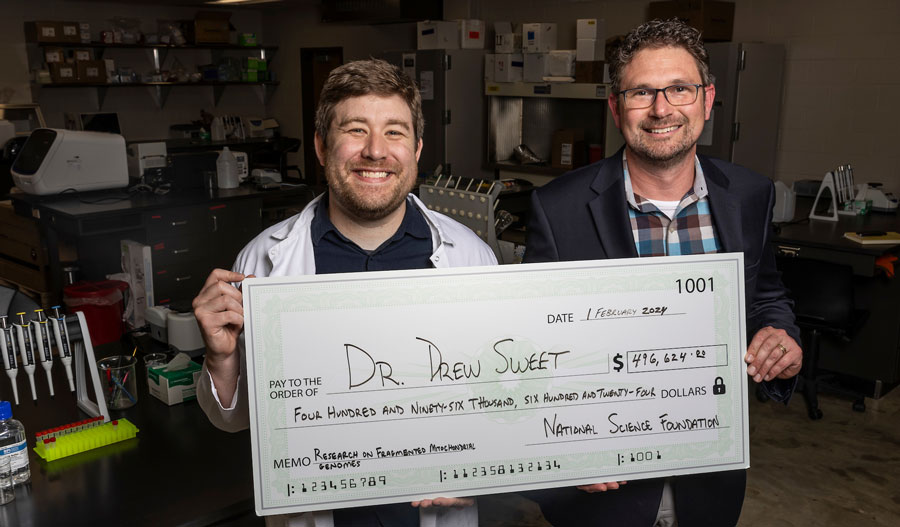With National Science Foundation Grant, Sweet Hopes to Solve Animal Cell Mysteries

Dr. Drew Sweet, assistant professor of evolutionary biology, with Dr. Travis Marsico (right), vice provost for research, innovation and discovery and executive director of the Arkansas Biosciences Institute at A-State.
JONESBORO – The lead investigator for a National Science Foundation-funded grant is on a hunt, seeking to unlock clues dating back millions of years to better understand the function of animal cells.
The $1.1 million grant will fund a three-year collaboration between researchers at Arkansas State University, Purdue University, and the University of Illinois Urbana-Champaign. A-State’s portion is $496,000.
“The project will focus on understanding the evolution of mitochondrial genomes in parasitic lice,” says Dr. Andrew D. Sweet, assistant professor of evolutionary biology in A-State’s Department of Biological Sciences.
Sweet and co-principal investigators at the other institutions will study how these lice have managed to survive over the last 100 million years despite some rare genetic features.
“Lice have unique mitochondrial genomes compared to most other animals, so figuring out how and why the genomes evolve could help us to better understand the function of animal cells,” Sweet said.
Most animals have genetic information in their mitochondria that is contained on a single, circular molecule, the ‘mitochondrial genome.’
“When the mitochondrial genomes of an organism are separated onto separate, smaller fragments, that is usually not good news,” Sweet explained. “When these fragmented genomes show up in humans and other organisms, it’s often associated with cell death and diseases. However, for some reason, several species of parasitic lice have fragmented mitochondrial genomes and seem to function just fine.”
Through his research, he hopes to find out why.
The grant includes support for three Ph.D. students, with one at A-State; one postdoc at A-State; and at least nine undergraduates, with at least three at A-State.
“We are always proud when our researchers secure external funding in support of important and fascinating research projects,” said Dr. Travis Marsico, vice provost for research, innovation and discovery and executive director of the Arkansas Biosciences Institute at A-State.
Marsico emphasized the significance of Sweet’s success when competing with researchers from throughout the country, including those at R1 institutions, for funding from the National Science Foundation’s Division of Environmental Biology.
“As we continue to grow the research enterprise at Arkansas State University and give our students world-class research experiences,” Marsico added, “funded research projects like Dr. Sweet’s will become more common. I’m grateful for his efforts, and I’m excited to keep updated about what he will discover."
Sweet’s connections with colleagues at Purdue and Illinois go way back. His co-principal investigators (co-PIs) are his former Ph.D. supervisor at Illinois and his former postdoc supervisor at Purdue.
Mitochondrial, which are the parts of the cell that generate energy, were originally free-living bacteria that developed symbiotic relationships with other cells billions of years ago, he explained. The original bacteria had their own genetic information, the bacterial genome.
“Much of this genetic information was lost after the bacteria formed symbiotic relationships with other early cells, but some of that genetic information remains to this day. The remaining genetic information contained in a mitochondrion is the ‘mitochondrial genome,’” Sweet continued.
Fragmented mitochondrial genomes evolved independently in several different groups of lice, but the scientists do not know exactly how often this happens, nor how stable the genomes are. For instance, some lice have three fragments, whereas others have up to 20 fragments. Sweet has many questions.
“Is this stable? Do the number of fragments change rapidly through time? And by time, we’re often talking millions of years. Lice are at least 100 million years old.”
May the hunt begin.
# # #





